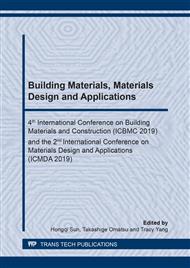p.50
p.57
p.64
p.69
p.77
p.84
p.93
p.99
p.105
Influence of Thickness of Air Gap on Concrete Curing in Formwork with Transparent Cover
Abstract:
Heat treatment of concrete is used to speed up its curing. Therefore, this process allows getting complete product in a short time and it is used at the plants for manufacturing of concrete elements. Fossil fuels are used for this purpose. An important task for engineers and scientists is to reduce costs of the manufacturing and make it ecological by introducing energy-saving technologies and renewable energy resources. The employment of solar energy for heat treatment is one of the ways to settle the problem. However, the efficiency of such engineering solution depends on type and construction of the solar energy equipment. The formwork, equipped by transparent cover, is chosen as the object of research. The research work is devoted to determination of optimal thickness of air gap between concrete element and transparent cover of the formwork. The results and methodology, as well as the information about materials and boundary conditions of the experiments are given in the research work. The obtained results allow increasing efficiency of employment of solar energy for manufacturing of concrete elements at the plants.
Info:
Periodical:
Pages:
77-83
Citation:
Online since:
October 2019
Authors:
Keywords:
Price:
Сopyright:
© 2019 Trans Tech Publications Ltd. All Rights Reserved
Share:
Citation:


